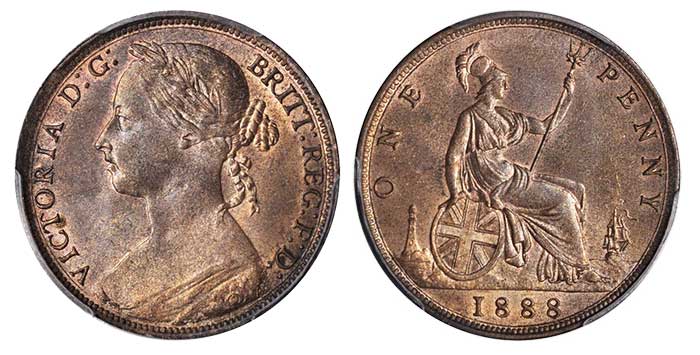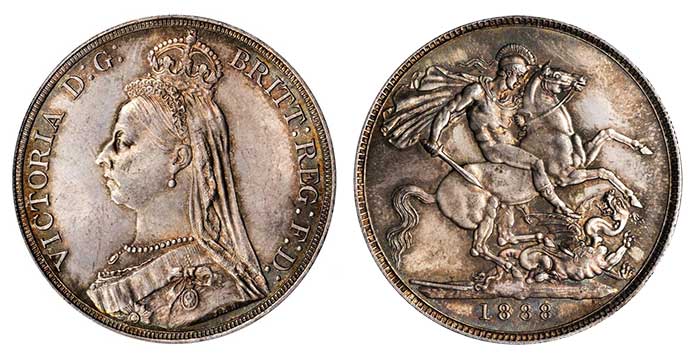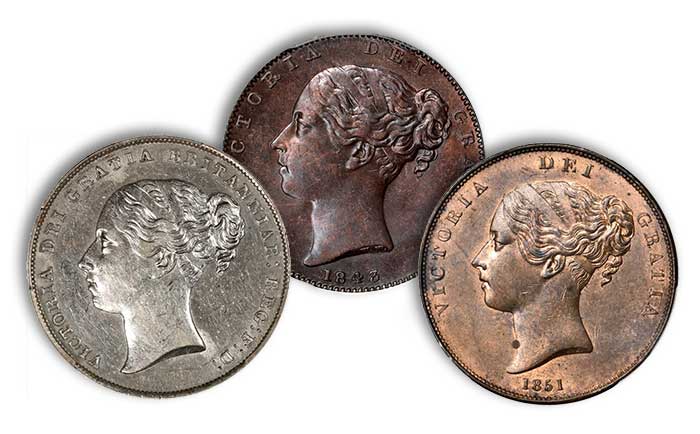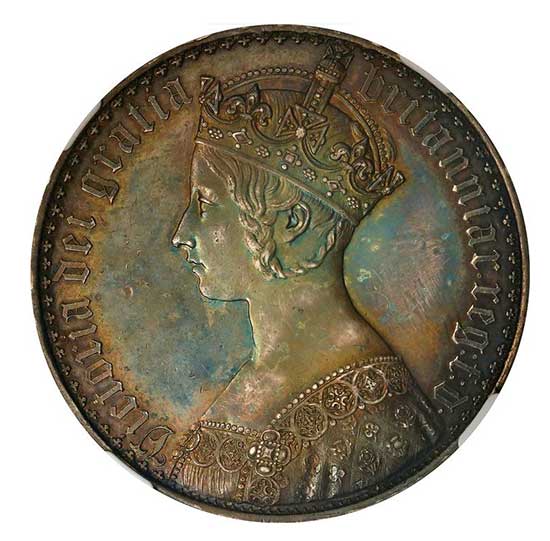
By Tyler Rossi for CoinWeek …..
Over the past seven years, it seems as if true crime and serial killer podcasts have become ingrained in the popular zeitgeist. Starting with the SERIAL podcast, the number of podcasts has skyrocketed, and now four of the top podcasts on Apple’s Podcast App are focused on true crime. As Americans, when we think about the most famous serial killers, we generally gravitate towards the likes of John Wayne Gacy and Ted Bundy. However, in England, “Jack the Ripper” is a perennial chart-topper.
An unidentified killer to this day, Jack the Ripper–or the “Whitechapel Murderer“, as he was also known–terrorized London’s East End over three months in 1888. In fact, it wasn’t until the newspapers published a letter signed by an individual named Jack the Ripper, supposedly written by the killer, that the murderer received the infamous moniker. Today, the letter is believed to have been written not by the killer but by a group of journalists trying to gin up interest and increase sales.
The individuals murdered by Jack the Ripper, at least the ones that follow the killer’s MO, were mostly female East End prostitutes. One reason these crimes shocked Victorian London to the degree that they did was the extremely brutal nature of each killing. Of the 11 women murdered in Whitechapel between 1888 and 1891, it is believed that five or six can be attributed to Jack the Ripper. Each victim, a poor white prostitute between 24 and 45 years old, was killed by strangulation, had their throats cut, and then suffered a series of violent and degrading postmortem mutilations.
While history has shown that we humans have a strong proclivity for voyeurism, as a numismatist, I tend to think of historical events in numismatic terms (not that such an emphasis can’t also be voyeuristic). So in this case, what was the numismatic scene in England at the time of the murders?
First, we start off with the circulating coinage that was being minted contemporaneously.

By 1888, Queen Victoria was 69 years old and had been on the throne for 51 years. At this time, however, her coinage still bore the portrait of a much younger woman. All bronze denominations (the half penny, penny, and farthing) depicted the 1860 Bun Head type portrait. Designed by famed British designer Leonard Charles Wyon, the obverse is centered on a left-facing bust of Victoria. The Queen is featured with her hair tied back in a plaited bun with a wreath of leaves and berries upon her head that is tied with ribbons visible below her bun. Victoria is wearing a highly elaborate bodice and a mantle decorated with a rose, thistle, and shamrock. This design, created by Wyon only after many personal sittings with the Queen, would be used up until 1889, when it was finally updated.
The reverse of these denominations all depict the same design: a helmeted figure of Britannia seated with a trident in her left hand and a shield bearing the Union Jack in her right. Behind Britannia is a seascape featuring a lighthouse and a multi-masted sailing ship. The denomination is written above and the date is inscribed in the exergue below. While all three denominations were struck periodically by the private Ralph Heaton & Sons mint of Birmingham during the 1870s and ’80s, by 1888 they had been struck exclusively by the Royal Mint at Tower Hill for six years.

For all specie coins, the gold and silver denominations, the royal portrait had been updated one year prior to the Jack the Ripper killings. Marking the Queen’s Golden Jubilee, the Jubilee portrait designed by Joseph Edgar Boehm depicts a more realistic portrait of a mature monarch who had experienced the loss of her beloved Prince Albert. At the age of 68, her nose is much sharper, her face fuller, and her eyes slightly sunken. The Queen is shown wearing her famous lightweight diamond crown and a morning veil.

While all eight circulation silver and gold denominations share this obverse design, the reverses are quite different. The silver three- and six-pence denominations both depict a crowned denomination dividing the date, all within an oak wreath. The silver 1 Shilling coin depicts the Crowned Royal shield surrounded by a garter, with the divided date below. The silver 1 and 2 Florin coins depict four crowned cruciform shields divided by four scepters, each with national emblems, all around a central garter star. Similarly to the Shilling, the silver Half Crown depicts the Crowned Royal shield surrounded by the garter. This design is also encircled by a highly intricate collar. For the largest silver denomination, a Crown, Victoria reused Benedetto Pistrucci’s design featuring St. George on horseback slaying the dragon that was first issued on the 1817 Sovereigns of George III. This same design was used for the 1888 Sovereign.
Now, unlike a paper note that lasts between five and eight years, a coin has an extended lifespan. While the United States Federal Reserve estimates that the average lifespan of a coin is 30 years, the Royal Mint actually stretches that to 40 years – and many coins throughout history have been known to circulate for upwards of a hundred years or more. When picking through your pocket change now, it is not out of the question to find Wheat cents from the 1930s and ’40s. It’s important to note that today since the vast majority of countries have stopped issuing circulating silver coins, it is highly unlikely to find silver in change. That being said, in Victorian England in the late 1880s, silver was a common sight in coinage.
So what older coinage might a person traversing the East End of London one night in 1888 have had in their pockets? Let’s start by looking at coins struck between 30 and 40 years prior, from 1848 through 1858.

Unlike later periods, in this early portion of Queen Victoria’s reign, nearly all denominations shared the same obverse Young Head type design. Released in 1838, this type was created by William Wyon, then Chief Engraver at the Royal Mint and father of Leonard. Employing a handsome neoclassical style, this design shows the young new queen in a left-facing bust with her hair in a loose bun, and a double ribbon or fillet tied over her head. The design was modified once in 1848 when the bust was increased in size and again in 1867 when the portrait was aged slightly.
As in 1888, the Royal Mint struck the same three copper denominations, the ½ penny, the penny, and the farthing. The reverse design is very similar to the later types and depicts a large, seated figure of Britannia facing right and holding a trident in her left hand and a Union Jack shield in her right. But there is neither a seascape nor a denomination, and the date is instead on the obverse beneath the Queen’s bust.
Interestingly, the silver four-pence denomination has a very similar reverse Britannia design. This coin, however, does include the denomination and date on the reverse. The silver six-pence and Shilling denominations both have the same crowned denomination dividing the date, all within an oak wreath like the 1888 three and six-pence types. The Half Crown reverse, created by Jean Baptiste Merlen, depicts the royal crowned quartered shield of arms within an olive wreath all encircled by the legend.

It is also highly probable that both the standard Gothic type and “Godless” type Florins still circulated in 1888. The Godless type, struck in 1848, depicts Victoria wearing a highly ornate crown with her hair braided down the side. Her dress is embroidered with roses, thistles, and shamrocks symbolizing England, Scotland, and Ireland. This coin is called the “Godless” Florin because the obverse legend did not include D.G. for Dei Gratia. After a public outcry, all later types included this in the legend. The reverse of these Florins depicted crowned cruciform shields of arms in a gothic style, all surrounding a central Tudor rose.
Both gold denominations, the Half Sovereign and the Sovereign, depict slightly different variations of the crowned royal quartered shield of arms.
Looking back to the outer limits of a coin’s circulating age, there may have been coins upwards of 75 to 100 years old still in circulation in 1888. These coins would have depicted Victoria’s uncles, Kings William IV and George IV, as well as her grandfather, King George III.
Coming to the throne in 1830, and reigning for seven short years, William IV struck many of the same denominations as his niece. As the reverses of these coins have similar designs to the later Victorian denominations, the difference mainly lies in the king’s uncrowned obverse portrait. Created by William Wyon, this bust shows the king with a receding hairline.

Prior to William IV, George IV sat on the throne from 1820 to 1830. His short reign was due to the Regency period when George III was mentally unfit to rule yet still lived. As a result, George IV was forced to wait in the wings as Prince Regent until 1820. During his short sole reign, George IV struck 10 different circulation denominations just for the UK home countries. Due to their high mintages, the most likely denominations to still be in active circulation in 1888 were his Britannia farthings, half pennies, and pennies. Additionally, an occasional Shilling or Half Crown coin would probably pop up.
Even older coins of George III could also possibly have been used, but this is less likely. While the British Government didn’t, and still doesn’t, pull coins of deceased monarchs from circulation all at once, these early 19th-century monarchs did not strike massive quantities of silver coinage. Meanwhile, their bronze and copper coinages, the economic workhorses of early modern industrialized economies, circulated heavily.
* * *
Sources
Keppel et al, 2005 – The Jack the Ripper Murders: A Modus Operandi and Signature Analysis of the 1888–1891 Whitechapel Murders
Standard Catalog of World Coins – 1801–1900, 9th Edition. Krause Publications (2019)
T. J. Cole, 1976 – The Lifetime of Coins in Circulation
* * *
About the Author
Tyler Rossi is currently a graduate student at Brandeis University’s Heller School of Social Policy and Management and studies Sustainable International Development and Conflict Resolution. Before graduating from American University in Washington D.C., he worked for Save the Children creating and running international development projects. Recently, Tyler returned to the US from living abroad in the Republic of North Macedonia, where he served as a Peace Corps volunteer for three years. Tyler is an avid numismatist and for over a decade has cultivated a deep interest in pre-modern and ancient coinage from around the world. He is a member of the American Numismatic Association (ANA).




